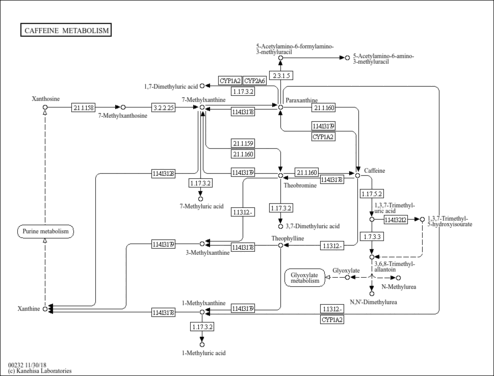| 5-Acetylamino-6-amino-3-methyluracil,1TMS,isomer #1 | CC(=O)NC1=C(N[Si](C)(C)C)[NH]C(=O)N(C)C1=O | 2020.8 | Semi standard non polar | 33892256 |
| 5-Acetylamino-6-amino-3-methyluracil,1TMS,isomer #1 | CC(=O)NC1=C(N[Si](C)(C)C)[NH]C(=O)N(C)C1=O | 2124.8 | Standard non polar | 33892256 |
| 5-Acetylamino-6-amino-3-methyluracil,1TMS,isomer #1 | CC(=O)NC1=C(N[Si](C)(C)C)[NH]C(=O)N(C)C1=O | 3947.4 | Standard polar | 33892256 |
| 5-Acetylamino-6-amino-3-methyluracil,1TMS,isomer #2 | CC(=O)NC1=C(N)N([Si](C)(C)C)C(=O)N(C)C1=O | 2026.1 | Semi standard non polar | 33892256 |
| 5-Acetylamino-6-amino-3-methyluracil,1TMS,isomer #2 | CC(=O)NC1=C(N)N([Si](C)(C)C)C(=O)N(C)C1=O | 2134.8 | Standard non polar | 33892256 |
| 5-Acetylamino-6-amino-3-methyluracil,1TMS,isomer #2 | CC(=O)NC1=C(N)N([Si](C)(C)C)C(=O)N(C)C1=O | 3852.4 | Standard polar | 33892256 |
| 5-Acetylamino-6-amino-3-methyluracil,1TMS,isomer #3 | CC(=O)N(C1=C(N)[NH]C(=O)N(C)C1=O)[Si](C)(C)C | 1917.2 | Semi standard non polar | 33892256 |
| 5-Acetylamino-6-amino-3-methyluracil,1TMS,isomer #3 | CC(=O)N(C1=C(N)[NH]C(=O)N(C)C1=O)[Si](C)(C)C | 1991.2 | Standard non polar | 33892256 |
| 5-Acetylamino-6-amino-3-methyluracil,1TMS,isomer #3 | CC(=O)N(C1=C(N)[NH]C(=O)N(C)C1=O)[Si](C)(C)C | 3261.7 | Standard polar | 33892256 |
| 5-Acetylamino-6-amino-3-methyluracil,2TMS,isomer #1 | CC(=O)N(C1=C(N[Si](C)(C)C)[NH]C(=O)N(C)C1=O)[Si](C)(C)C | 1904.5 | Semi standard non polar | 33892256 |
| 5-Acetylamino-6-amino-3-methyluracil,2TMS,isomer #1 | CC(=O)N(C1=C(N[Si](C)(C)C)[NH]C(=O)N(C)C1=O)[Si](C)(C)C | 2123.0 | Standard non polar | 33892256 |
| 5-Acetylamino-6-amino-3-methyluracil,2TMS,isomer #1 | CC(=O)N(C1=C(N[Si](C)(C)C)[NH]C(=O)N(C)C1=O)[Si](C)(C)C | 2881.3 | Standard polar | 33892256 |
| 5-Acetylamino-6-amino-3-methyluracil,2TMS,isomer #2 | CC(=O)NC1=C(N([Si](C)(C)C)[Si](C)(C)C)[NH]C(=O)N(C)C1=O | 1982.4 | Semi standard non polar | 33892256 |
| 5-Acetylamino-6-amino-3-methyluracil,2TMS,isomer #2 | CC(=O)NC1=C(N([Si](C)(C)C)[Si](C)(C)C)[NH]C(=O)N(C)C1=O | 2235.7 | Standard non polar | 33892256 |
| 5-Acetylamino-6-amino-3-methyluracil,2TMS,isomer #2 | CC(=O)NC1=C(N([Si](C)(C)C)[Si](C)(C)C)[NH]C(=O)N(C)C1=O | 3530.0 | Standard polar | 33892256 |
| 5-Acetylamino-6-amino-3-methyluracil,2TMS,isomer #3 | CC(=O)NC1=C(N[Si](C)(C)C)N([Si](C)(C)C)C(=O)N(C)C1=O | 2083.7 | Semi standard non polar | 33892256 |
| 5-Acetylamino-6-amino-3-methyluracil,2TMS,isomer #3 | CC(=O)NC1=C(N[Si](C)(C)C)N([Si](C)(C)C)C(=O)N(C)C1=O | 2236.1 | Standard non polar | 33892256 |
| 5-Acetylamino-6-amino-3-methyluracil,2TMS,isomer #3 | CC(=O)NC1=C(N[Si](C)(C)C)N([Si](C)(C)C)C(=O)N(C)C1=O | 3460.5 | Standard polar | 33892256 |
| 5-Acetylamino-6-amino-3-methyluracil,2TMS,isomer #4 | CC(=O)N(C1=C(N)N([Si](C)(C)C)C(=O)N(C)C1=O)[Si](C)(C)C | 1969.8 | Semi standard non polar | 33892256 |
| 5-Acetylamino-6-amino-3-methyluracil,2TMS,isomer #4 | CC(=O)N(C1=C(N)N([Si](C)(C)C)C(=O)N(C)C1=O)[Si](C)(C)C | 2070.6 | Standard non polar | 33892256 |
| 5-Acetylamino-6-amino-3-methyluracil,2TMS,isomer #4 | CC(=O)N(C1=C(N)N([Si](C)(C)C)C(=O)N(C)C1=O)[Si](C)(C)C | 3045.9 | Standard polar | 33892256 |
| 5-Acetylamino-6-amino-3-methyluracil,3TMS,isomer #1 | CC(=O)N(C1=C(N([Si](C)(C)C)[Si](C)(C)C)[NH]C(=O)N(C)C1=O)[Si](C)(C)C | 1957.3 | Semi standard non polar | 33892256 |
| 5-Acetylamino-6-amino-3-methyluracil,3TMS,isomer #1 | CC(=O)N(C1=C(N([Si](C)(C)C)[Si](C)(C)C)[NH]C(=O)N(C)C1=O)[Si](C)(C)C | 2211.1 | Standard non polar | 33892256 |
| 5-Acetylamino-6-amino-3-methyluracil,3TMS,isomer #1 | CC(=O)N(C1=C(N([Si](C)(C)C)[Si](C)(C)C)[NH]C(=O)N(C)C1=O)[Si](C)(C)C | 2498.9 | Standard polar | 33892256 |
| 5-Acetylamino-6-amino-3-methyluracil,3TMS,isomer #2 | CC(=O)N(C1=C(N[Si](C)(C)C)N([Si](C)(C)C)C(=O)N(C)C1=O)[Si](C)(C)C | 2041.6 | Semi standard non polar | 33892256 |
| 5-Acetylamino-6-amino-3-methyluracil,3TMS,isomer #2 | CC(=O)N(C1=C(N[Si](C)(C)C)N([Si](C)(C)C)C(=O)N(C)C1=O)[Si](C)(C)C | 2204.4 | Standard non polar | 33892256 |
| 5-Acetylamino-6-amino-3-methyluracil,3TMS,isomer #2 | CC(=O)N(C1=C(N[Si](C)(C)C)N([Si](C)(C)C)C(=O)N(C)C1=O)[Si](C)(C)C | 2537.7 | Standard polar | 33892256 |
| 5-Acetylamino-6-amino-3-methyluracil,3TMS,isomer #3 | CC(=O)NC1=C(N([Si](C)(C)C)[Si](C)(C)C)N([Si](C)(C)C)C(=O)N(C)C1=O | 2133.4 | Semi standard non polar | 33892256 |
| 5-Acetylamino-6-amino-3-methyluracil,3TMS,isomer #3 | CC(=O)NC1=C(N([Si](C)(C)C)[Si](C)(C)C)N([Si](C)(C)C)C(=O)N(C)C1=O | 2344.6 | Standard non polar | 33892256 |
| 5-Acetylamino-6-amino-3-methyluracil,3TMS,isomer #3 | CC(=O)NC1=C(N([Si](C)(C)C)[Si](C)(C)C)N([Si](C)(C)C)C(=O)N(C)C1=O | 3055.4 | Standard polar | 33892256 |
| 5-Acetylamino-6-amino-3-methyluracil,4TMS,isomer #1 | CC(=O)N(C1=C(N([Si](C)(C)C)[Si](C)(C)C)N([Si](C)(C)C)C(=O)N(C)C1=O)[Si](C)(C)C | 2148.9 | Semi standard non polar | 33892256 |
| 5-Acetylamino-6-amino-3-methyluracil,4TMS,isomer #1 | CC(=O)N(C1=C(N([Si](C)(C)C)[Si](C)(C)C)N([Si](C)(C)C)C(=O)N(C)C1=O)[Si](C)(C)C | 2321.7 | Standard non polar | 33892256 |
| 5-Acetylamino-6-amino-3-methyluracil,4TMS,isomer #1 | CC(=O)N(C1=C(N([Si](C)(C)C)[Si](C)(C)C)N([Si](C)(C)C)C(=O)N(C)C1=O)[Si](C)(C)C | 2288.1 | Standard polar | 33892256 |
| 5-Acetylamino-6-amino-3-methyluracil,1TBDMS,isomer #1 | CC(=O)NC1=C(N[Si](C)(C)C(C)(C)C)[NH]C(=O)N(C)C1=O | 2277.9 | Semi standard non polar | 33892256 |
| 5-Acetylamino-6-amino-3-methyluracil,1TBDMS,isomer #1 | CC(=O)NC1=C(N[Si](C)(C)C(C)(C)C)[NH]C(=O)N(C)C1=O | 2350.1 | Standard non polar | 33892256 |
| 5-Acetylamino-6-amino-3-methyluracil,1TBDMS,isomer #1 | CC(=O)NC1=C(N[Si](C)(C)C(C)(C)C)[NH]C(=O)N(C)C1=O | 3820.7 | Standard polar | 33892256 |
| 5-Acetylamino-6-amino-3-methyluracil,1TBDMS,isomer #2 | CC(=O)NC1=C(N)N([Si](C)(C)C(C)(C)C)C(=O)N(C)C1=O | 2265.8 | Semi standard non polar | 33892256 |
| 5-Acetylamino-6-amino-3-methyluracil,1TBDMS,isomer #2 | CC(=O)NC1=C(N)N([Si](C)(C)C(C)(C)C)C(=O)N(C)C1=O | 2350.0 | Standard non polar | 33892256 |
| 5-Acetylamino-6-amino-3-methyluracil,1TBDMS,isomer #2 | CC(=O)NC1=C(N)N([Si](C)(C)C(C)(C)C)C(=O)N(C)C1=O | 3785.4 | Standard polar | 33892256 |
| 5-Acetylamino-6-amino-3-methyluracil,1TBDMS,isomer #3 | CC(=O)N(C1=C(N)[NH]C(=O)N(C)C1=O)[Si](C)(C)C(C)(C)C | 2160.2 | Semi standard non polar | 33892256 |
| 5-Acetylamino-6-amino-3-methyluracil,1TBDMS,isomer #3 | CC(=O)N(C1=C(N)[NH]C(=O)N(C)C1=O)[Si](C)(C)C(C)(C)C | 2206.4 | Standard non polar | 33892256 |
| 5-Acetylamino-6-amino-3-methyluracil,1TBDMS,isomer #3 | CC(=O)N(C1=C(N)[NH]C(=O)N(C)C1=O)[Si](C)(C)C(C)(C)C | 3238.0 | Standard polar | 33892256 |
| 5-Acetylamino-6-amino-3-methyluracil,2TBDMS,isomer #1 | CC(=O)N(C1=C(N[Si](C)(C)C(C)(C)C)[NH]C(=O)N(C)C1=O)[Si](C)(C)C(C)(C)C | 2357.4 | Semi standard non polar | 33892256 |
| 5-Acetylamino-6-amino-3-methyluracil,2TBDMS,isomer #1 | CC(=O)N(C1=C(N[Si](C)(C)C(C)(C)C)[NH]C(=O)N(C)C1=O)[Si](C)(C)C(C)(C)C | 2527.2 | Standard non polar | 33892256 |
| 5-Acetylamino-6-amino-3-methyluracil,2TBDMS,isomer #1 | CC(=O)N(C1=C(N[Si](C)(C)C(C)(C)C)[NH]C(=O)N(C)C1=O)[Si](C)(C)C(C)(C)C | 2905.5 | Standard polar | 33892256 |
| 5-Acetylamino-6-amino-3-methyluracil,2TBDMS,isomer #2 | CC(=O)NC1=C(N([Si](C)(C)C(C)(C)C)[Si](C)(C)C(C)(C)C)[NH]C(=O)N(C)C1=O | 2469.4 | Semi standard non polar | 33892256 |
| 5-Acetylamino-6-amino-3-methyluracil,2TBDMS,isomer #2 | CC(=O)NC1=C(N([Si](C)(C)C(C)(C)C)[Si](C)(C)C(C)(C)C)[NH]C(=O)N(C)C1=O | 2668.6 | Standard non polar | 33892256 |
| 5-Acetylamino-6-amino-3-methyluracil,2TBDMS,isomer #2 | CC(=O)NC1=C(N([Si](C)(C)C(C)(C)C)[Si](C)(C)C(C)(C)C)[NH]C(=O)N(C)C1=O | 3417.7 | Standard polar | 33892256 |
| 5-Acetylamino-6-amino-3-methyluracil,2TBDMS,isomer #3 | CC(=O)NC1=C(N[Si](C)(C)C(C)(C)C)N([Si](C)(C)C(C)(C)C)C(=O)N(C)C1=O | 2563.5 | Semi standard non polar | 33892256 |
| 5-Acetylamino-6-amino-3-methyluracil,2TBDMS,isomer #3 | CC(=O)NC1=C(N[Si](C)(C)C(C)(C)C)N([Si](C)(C)C(C)(C)C)C(=O)N(C)C1=O | 2657.8 | Standard non polar | 33892256 |
| 5-Acetylamino-6-amino-3-methyluracil,2TBDMS,isomer #3 | CC(=O)NC1=C(N[Si](C)(C)C(C)(C)C)N([Si](C)(C)C(C)(C)C)C(=O)N(C)C1=O | 3331.2 | Standard polar | 33892256 |
| 5-Acetylamino-6-amino-3-methyluracil,2TBDMS,isomer #4 | CC(=O)N(C1=C(N)N([Si](C)(C)C(C)(C)C)C(=O)N(C)C1=O)[Si](C)(C)C(C)(C)C | 2441.3 | Semi standard non polar | 33892256 |
| 5-Acetylamino-6-amino-3-methyluracil,2TBDMS,isomer #4 | CC(=O)N(C1=C(N)N([Si](C)(C)C(C)(C)C)C(=O)N(C)C1=O)[Si](C)(C)C(C)(C)C | 2521.3 | Standard non polar | 33892256 |
| 5-Acetylamino-6-amino-3-methyluracil,2TBDMS,isomer #4 | CC(=O)N(C1=C(N)N([Si](C)(C)C(C)(C)C)C(=O)N(C)C1=O)[Si](C)(C)C(C)(C)C | 3047.0 | Standard polar | 33892256 |
| 5-Acetylamino-6-amino-3-methyluracil,3TBDMS,isomer #1 | CC(=O)N(C1=C(N([Si](C)(C)C(C)(C)C)[Si](C)(C)C(C)(C)C)[NH]C(=O)N(C)C1=O)[Si](C)(C)C(C)(C)C | 2606.9 | Semi standard non polar | 33892256 |
| 5-Acetylamino-6-amino-3-methyluracil,3TBDMS,isomer #1 | CC(=O)N(C1=C(N([Si](C)(C)C(C)(C)C)[Si](C)(C)C(C)(C)C)[NH]C(=O)N(C)C1=O)[Si](C)(C)C(C)(C)C | 2826.4 | Standard non polar | 33892256 |
| 5-Acetylamino-6-amino-3-methyluracil,3TBDMS,isomer #1 | CC(=O)N(C1=C(N([Si](C)(C)C(C)(C)C)[Si](C)(C)C(C)(C)C)[NH]C(=O)N(C)C1=O)[Si](C)(C)C(C)(C)C | 2754.6 | Standard polar | 33892256 |
| 5-Acetylamino-6-amino-3-methyluracil,3TBDMS,isomer #2 | CC(=O)N(C1=C(N[Si](C)(C)C(C)(C)C)N([Si](C)(C)C(C)(C)C)C(=O)N(C)C1=O)[Si](C)(C)C(C)(C)C | 2672.2 | Semi standard non polar | 33892256 |
| 5-Acetylamino-6-amino-3-methyluracil,3TBDMS,isomer #2 | CC(=O)N(C1=C(N[Si](C)(C)C(C)(C)C)N([Si](C)(C)C(C)(C)C)C(=O)N(C)C1=O)[Si](C)(C)C(C)(C)C | 2819.3 | Standard non polar | 33892256 |
| 5-Acetylamino-6-amino-3-methyluracil,3TBDMS,isomer #2 | CC(=O)N(C1=C(N[Si](C)(C)C(C)(C)C)N([Si](C)(C)C(C)(C)C)C(=O)N(C)C1=O)[Si](C)(C)C(C)(C)C | 2775.2 | Standard polar | 33892256 |
| 5-Acetylamino-6-amino-3-methyluracil,3TBDMS,isomer #3 | CC(=O)NC1=C(N([Si](C)(C)C(C)(C)C)[Si](C)(C)C(C)(C)C)N([Si](C)(C)C(C)(C)C)C(=O)N(C)C1=O | 2765.8 | Semi standard non polar | 33892256 |
| 5-Acetylamino-6-amino-3-methyluracil,3TBDMS,isomer #3 | CC(=O)NC1=C(N([Si](C)(C)C(C)(C)C)[Si](C)(C)C(C)(C)C)N([Si](C)(C)C(C)(C)C)C(=O)N(C)C1=O | 2942.9 | Standard non polar | 33892256 |
| 5-Acetylamino-6-amino-3-methyluracil,3TBDMS,isomer #3 | CC(=O)NC1=C(N([Si](C)(C)C(C)(C)C)[Si](C)(C)C(C)(C)C)N([Si](C)(C)C(C)(C)C)C(=O)N(C)C1=O | 3062.3 | Standard polar | 33892256 |
| 5-Acetylamino-6-amino-3-methyluracil,4TBDMS,isomer #1 | CC(=O)N(C1=C(N([Si](C)(C)C(C)(C)C)[Si](C)(C)C(C)(C)C)N([Si](C)(C)C(C)(C)C)C(=O)N(C)C1=O)[Si](C)(C)C(C)(C)C | 2927.2 | Semi standard non polar | 33892256 |
| 5-Acetylamino-6-amino-3-methyluracil,4TBDMS,isomer #1 | CC(=O)N(C1=C(N([Si](C)(C)C(C)(C)C)[Si](C)(C)C(C)(C)C)N([Si](C)(C)C(C)(C)C)C(=O)N(C)C1=O)[Si](C)(C)C(C)(C)C | 3078.3 | Standard non polar | 33892256 |
| 5-Acetylamino-6-amino-3-methyluracil,4TBDMS,isomer #1 | CC(=O)N(C1=C(N([Si](C)(C)C(C)(C)C)[Si](C)(C)C(C)(C)C)N([Si](C)(C)C(C)(C)C)C(=O)N(C)C1=O)[Si](C)(C)C(C)(C)C | 2711.1 | Standard polar | 33892256 |
